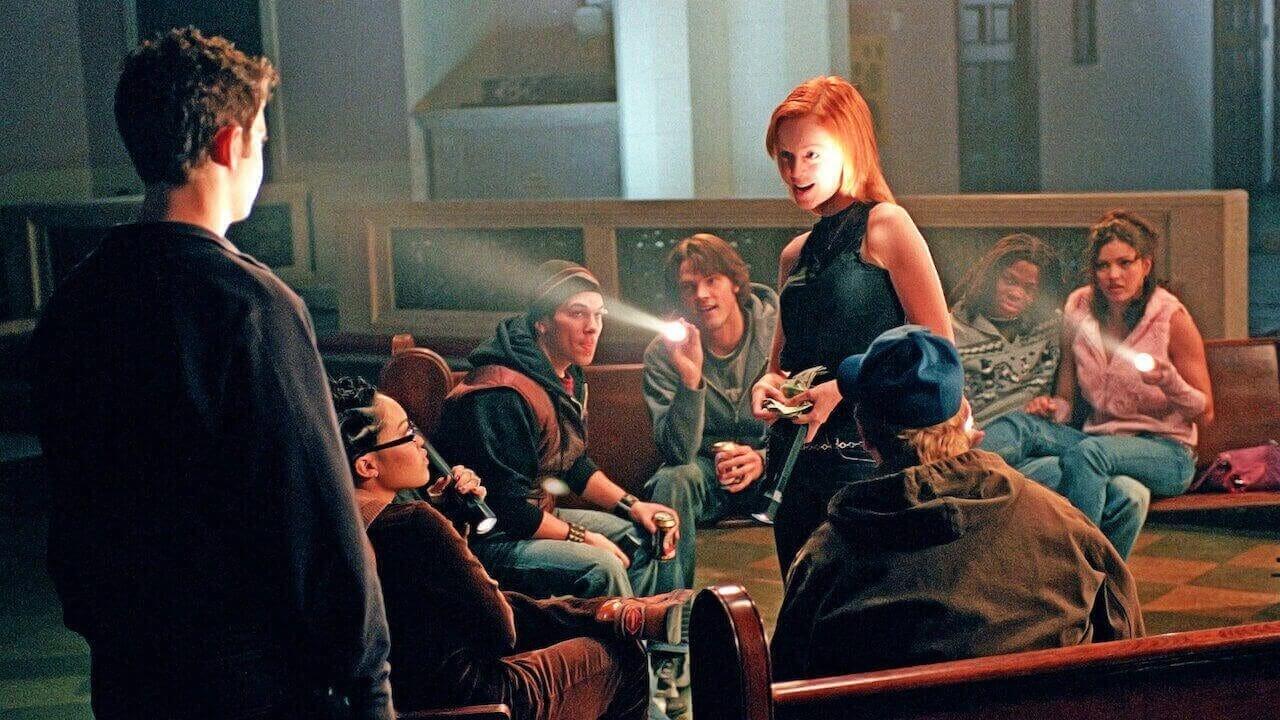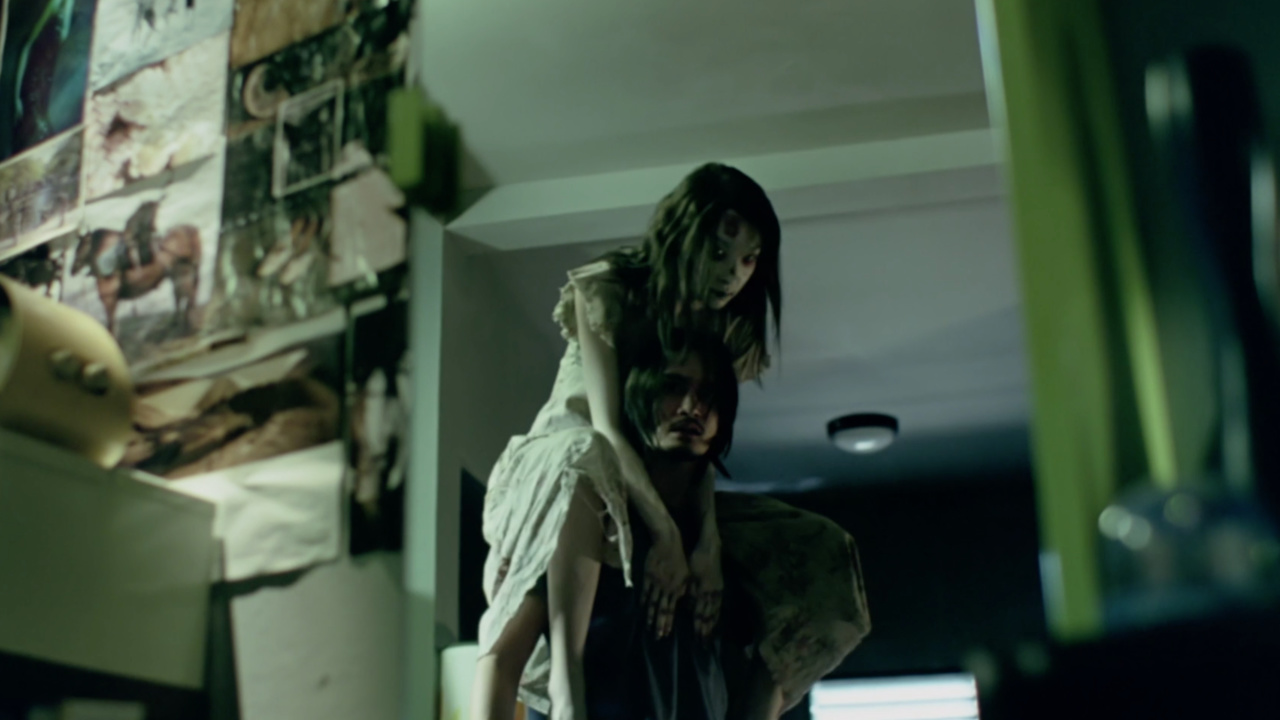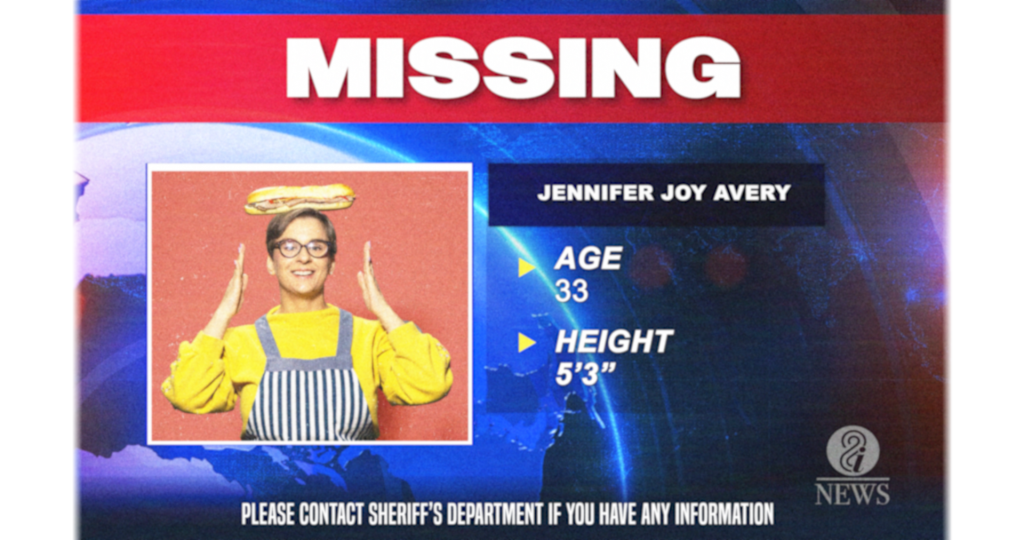Reviews
‘Cry_Wolf’ Review: The Aughts Slasher That Outsmarted ‘Scream’

What’s worse than summer ending and having to go back to school? How about transferring to an elite boarding school in the middle of the year? You’ve probably heard me talk endlessly about the hundreds of cardboard placeholders I got from Blockbuster when they were going out of business. One of the placeholders I had was for a film called Cry_Wolf. Something about the killer’s half-lit neon orange mask terrified me beyond belief. When my mom made me a display out of the placeholders, I was glad that Cry_Wolf was not one of the ones she picked. It wouldn’t be until my short-lived job at FYE in 2011 that I would finally have the guts to watch Cry_Wolf. It quickly became one of my favorites.
Cry_Wolf: A Hidden Gem in Aughts Horror
After getting kicked out of his previous boarding school, Owen Matthews (Julian Morris) arrives at Westlake Preparatory Academy. He quickly makes friends with Dodger (Lindy Booth) and his roommate, Tom (Jared Padalecki). Owen’s first night at Westlake is spent in the old chapel, where he is set to play a round of the lying game with the rest of Dodger and Tom’s friends. A quick display of critical thinking establishes Owen as a unique addition to their friend group. Owen’s addition to the crew brings a new version of the lying game when they decide to involve the rest of the school. On the heels of a local murder, Dodger and Owen blend reality and fiction when they create The Wolf. But it soon turns out that their creation may be more than a silly little email thread.
Before becoming a waning Blumhouse slop-maker, co-writer/director Jeff Wadlow slashed into the subgenre with this rowdy, slice-of-life slasher flick. Cry_Wolf didn’t intend to shake up the subgenre; rather, it accepted the slasher film for what it became and comfortably existed within those boundaries. Wadlow and co-writer/producer Beau Bauman utilized the somewhat carefree lives of teens and crafted horror around the things they knew and loved.
AIM and Chain Emails: Nostalgia in Horror
While I wasn’t an AIM kid, the utilization of AIM and email threads was prevalent in my life at this point. It also highlighted the fear felt in people like my mother, who wouldn’t let me have a Myspace account because you never know who’s on the other end of the keyboard. That fear is important in creating the horror and drama that surrounds Cry_Wolf. Everyone born before the year 2000 probably remembers the rampant chain emails that plagued our inboxes. It’s truly a surprise that chain emails weren’t a bigger thing in aughts horror. Cry_Wolf utilizes the creation of the chain email as the true catalyst of the film and allows AIM to really take the forefront on the technological aspects. From there, all hell breaks loose.
Cry_Wolf is a brash-looking film. From its Scream-like cover image to the overexposed, harshly lit visuals, Cry_Wolf has you wading in an of-its-time amount of film grain. What makes this film distinct from most others of its time is its soundtrack. Rather than assaulting our ears with the ever-dominant Nu metal/fart rock, we get a fairly ear-pleasing, Sugar Ray-esque soundtrack. Cry_Wolf should be rife with Korn, Sevendust, or at least some Goldfinger! But it’s not. The music we get is oddly complementary to the film’s garish visual style.
The Ultimate Slasher Villain
One of the reasons this film deserves to be talked about more is because of how truly great (by definition) the antagonist is. If you haven’t seen the film, then prepare for a major spoiler. It turns out that the entire friend group is playing a prank on Owen because he ruined the fun they were having with their game. BUT Dodger places a loaded gun in Professor Walker’s (Jon Bon Jovi) desk. Owen uses that gun to kill their professor when he’s led to believe that the professor has been the one committing the murders. The stinger of the film is that Owen realizes Dodger orchestrated this entire thing to facilitate the death of Professor Walker (after she learned he was seeing another (dead) student).
There are three rules to the lying game. Avoid suspicion, manipulate your friends, and eliminate your enemies. That’s exactly what Dodger does. She never cared about creating this gigantic [basically] ARG that involves the whole school. Dodger killed the student that Professor Walker was sleeping with, and she wanted him dead as retribution. Owen was the conduit that could make that happen.
Why Cry_Wolf Outsmarts Scream
You’ve heard me talk, ad nauseam, on the topic that Scream ruined the slasher subgenre. Cry_Wolf is one of the few films to outsmart Scream. Wadlow and Bauman expertly crafted one of the aughts’ greatest villains. Dodger uses every gift and talent she has to skew the outcome into the specific way she wants. Her cunningness and manipulation tactics are unparalleled in the subgenre.
Cry_Wolf is a diamond in the rough. Set in the middle of the aughts remakes of 80s classics and J-horror, it stands out as a very confident film. It may not have the tightest script, best acting, or most blood, but it knows what it is. And if you’ve ever wanted to see Gary Cole try a British accent, this is the film for you.
Reviews
‘Shutter’ (2004) Review: Is Aughts-ful

The aughts were the wild wild west when it came to remakes and reboots. One subgenre that excelled in striking fear into the hearts of North Americans was unquestionably J-horror. It was a craze that gave a 10-ish-year-old me nightmares for too much of my childhood. Out of all of the J-horror remakes that frightened me, the one I never got around to checking out was Shutter. Which is what I was initially going to open this review with. That was until I realized that Shutter wasn’t a J-horror remake! Talk about egg on my face!
A Haunting Tale in Japan
Shutter follows Ben Shaw (Joshua Jackson), a seasoned photographer who moves to Japan with his new wife Jane (Rachael Taylor). Their first night in Japan gets off to an awful start when Jane runs over a mysterious woman at night. Jane starts seeing this mysterious woman throughout her daily life, and Ben’s photos become unusable when a spirit takes them over one by one. Is this spirit coming after Ben and Jane for the accident? Or, is this spirit haunting them for a more sinister reason?
This hastily assembled remake is directed by Masayuki Ochiai and written by Luke Dawson. After Shutter, Dawson’s only other notable script would be the 2015 flop The Lazarus Effect. Which is what I was initially going to write until I learned that The Lazarus Effect brought in nearly $40 million at the box office. It’s difficult to say what the worst part of Shutter is, but the script is definitely at the top of that list. Not only is the script boring and bereft of any real terror, but the characters are beyond flat. Even without having seen Shutter (2004), it was clear what direction this film was taking, and any suspense that could have existed flew right out the window.
Failed Cultural Commentary
Dawson’s script attempts to take a look at white people forcibly inserting themselves into a culture and making it all about themselves. But it’s such a surface-level observation and handled with the care of a five-year-old’s crayon drawing that it’s nearly laughable. At the very least, Shutter does succeed at being a good-for-her film. And for that, I can tip my hat.
Director Masayuki Ochiai and cinematographer Katsumi Yanagijima fail to explore any space in any meaningful way. Japan is a beautiful location, and it’s completely wasted throughout this film. The only really visually interesting moment is the well-choreographed car crash. From there, things quickly go downhill. I’m sure there’s a way to make a film about spirit photography feel interesting and scary, but this is definitely not the right approach.
Shutter is a Forgettable Horror Flop
I’ve covered a lot of films during my tenure at Horror Press that I’ve never seen before. It’s a gamble I’m happy to risk. Whether they hit or miss doesn’t usually matter to me. For some reason, I held Shutter in high regard. I thought people were over the moon for this film. I suppose I can add this to my list of films, such as The Barrens and Warm Bodies, as ones I could easily consider a complete waste of time.
Reviews
Brooklyn Horror Film Festival 2025: ‘Buffet Infinity’ Review

Within the found footage subgenre exists an even more niche and untapped market. Screen life has slowly overtaken found footage; hardcore fans, like myself, ache for something different. One of the more interesting sub-subgenres of found footage is something that I don’t think has a name yet, so let’s name it here and now. How about…TV-gone-rogue! The TV-gone-rogue subgenre is small. Ghostwatch got the ball rolling for these gone rogue-like films, but there was radio silence for quite some time. It would be Chris LaMartina’s WNUF Halloween Special that really brought this idea back into the limelight. Many filmmakers have tried to make TV-gone-rogue interesting, and many have failed. That is until Simon Glassman stepped onto the scene with Buffet Infinity.
Buffet Infinity: A Chaotic Tale of Westridge
The town (city?) of Westridge is whisked into chaos when the new Buffet Infinity restaurant rolls into town. Local sandwich shop owner Jennifer Avery (Allison Bench) is the first to take the soon-to-be conglomerate to task with increasingly pointed advertisements. Suddenly, local restaurant owners/workers go missing in droves as Buffet Infinity expands into neighboring businesses. Sinkholes, missing cityfolk, quarantines, and mysterious sounds abound, leaving residents to ask one question…who really has the sauce?
On the Brooklyn Horror Film Festival schedule, the header image for Buffet Infinity shows multiple people T-posing and floating in the sky. I was immediately sold. I had no clue what I was getting into, and I didn’t want to know. The film was introduced as “one of the craziest we have this year.” (Slightly paraphrasing.) What was I about to watch? Little did I know, it was about to be an hour and forty minutes of small-town madness.
Writers Allison Bench and Elisia Snyder, and writer-director Simon Glassman, transport viewers into an upside down world of weaponized local ads; a thriving town invaded by the deep pockets of monopolized capitalism. As someone who grew up in a decently sized town, though probably not large enough to be considered a city, there was a tinge of nostalgia that accompanied Buffet Infinity. Westridge feels cozy and intimate, a town where everyone knows your name. It’s a “baked in a buttery flaky crust” town. Sure, they have their McDonald’s and Burger Kings, but the real townsfolk eat at Jennifer’s sandwich shop–local knitting circles murmur about what they think is in Jennifer’s secret sauce. Simply put, Westridge feels like a home that many people like myself grew up in. And it reminds us of a simpler time that’s long gone.

A Unique Blend of Humor and Eldritch Terror
Buffet Infinity hides its horror well. It slowly guides the viewer into a sense of unease. As easily as the creators have you laughing, they have you squirming. The absurdist joy quickly transforms into Eldritch terrors from beyond. Many filmmakers say they’re inspired by the idea of it’s-not-what-you-see that’s scary, but many times it feels performative. Bench, Glassman, and Snyder have crafted a truly special script that edges you with terror and excitement. They constantly push you to the edge of release, and then back away. It’s the Japanese water torture of exposition. And, for me, it works incredibly well.
One of the most important aspects of Buffet Infinity is the over-capitalization of our lives. While the creators tackle this idea in a tongue-in-cheek manner, their message is highly effective. For the most part. This constant tete-a-tete between Buffet Infinity and the locals is highly amusing, but brings a larger conversation to the forefront. The town I grew up in is a shadow of what it once was. And I know many feel the same about the towns they grew up in. I can already hear the moans of people who dislike this film: “Brandon, it’s not that deep.” And I would highly disagree. Buffet Infinity feels like a reflective protest film–a loud and proud middle finger at what we should have said when the Super Walmart put mom and pops out of business.
Sorry, this review has gone off the rails. Let’s reel it back in a bit.
Why Buffet Infinity Redefines Found Footage
Buffet Infinity is a riotous romp, a hilarious horror that goes from zero to 100 pretty damn fast. Each commercial slowly builds on its last and uniquely tells its story. This film sets a new precedent for the TV-gone-rogue subgenre. Not to directly compare, but a film like WNUF Halloween Special (a film I love) uses its commercials as a coda; it’s a separation of what you saw/heard and prepares you for the next movement. Buffet Infinity uses its commercial to create the story. Instead of watching news pieces, then irrelevant commercials, then back to news pieces, Buffet Infinity breaks the mold. Hell, it creates the mold.
As someone who has been dying to see a Welcome to Nightvale film, Buffet Infinity is the closest thing I could ask for. It is full of killer performances (looking at you, Ahmed Ahmed), is well-crafted, and sets a new precedent on an underutilized side of found footage. Buffet Infinity is a full-course meal. I highly suspect that Buffet Infinity will gather the unwavering support that Hundreds of Beavers gathered and will go on to be considered an instant classic of the 2020s.























